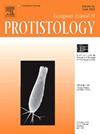Morphology and molecular phylogeny of Pelagothrix abietum (Penard, 1922) comb. nov. and two new Metacystis and Apolagynus species (Ciliophora, Prostomatea)
IF 1.6
2区 生物学
Q4 MICROBIOLOGY
引用次数: 0
Abstract
Ciliates of the class Prostomatea show a broad spectrum of feeding strategies and often occur abundantly in various aquatic habitats, playing a vital role in the biogeochemical cycle. Due to their small cell size and simple structure, prostomateans were considered to be a group with a lower degree of morphological differentiation for a long time. However, recent research suggests that the diversity of this group of ciliates is higher than previously thought. In the present study, three prostomateans, collected from different localities in China and classified into three families, were examined using morphological and phylogenetic techniques. Our analyses revealed two new species, Metacystis multitricha sp. nov. and Apolagynus spiralis sp. nov., and suggested a transfer of Prorodon abietum Penard, 1922 to the genus Pelagothrix. Phylogenetic analyses corroborated the morphological classifications of the three species into the families Metacystidae, Lagynusidae, and Holophryidae, respectively, demonstrating that their diagnostic characteristics bear an evolutionary signal at the family level.
Morphology and molecular phylogeny of Pelagothrix abietum (Penard, 1922) comb.
前列纤毛虫类纤毛虫的摄食策略多种多样,经常大量出现在各种水生生境中,在生物地球化学循环中扮演着重要角色。由于细胞体积小、结构简单,前列纤毛虫长期以来被认为是形态分化程度较低的一类。然而,最近的研究表明,这类纤毛虫的多样性比以前想象的要高。本研究利用形态学和系统发生学技术,对从中国不同地区采集到的三种前列纤毛虫进行了研究,并将其分为三科。我们的分析揭示了两个新物种:Metacystis multitricha sp.nov.和 Apolagynus spiralis sp.nov.,并建议将 Prorodon abietum Penard, 1922 移入 Pelagothrix 属。系统发生学分析证实了这三个物种分别归入 Metacystidae 科、Lagynusidae 科和 Holophryidae 科的形态学分类,表明它们的诊断特征具有科一级的进化信号。
本文章由计算机程序翻译,如有差异,请以英文原文为准。
求助全文
约1分钟内获得全文
求助全文
来源期刊

European journal of protistology
生物-微生物学
CiteScore
4.60
自引率
20.70%
发文量
55
审稿时长
14.6 weeks
期刊介绍:
Articles deal with protists, unicellular organisms encountered free-living in various habitats or as parasites or used in basic research or applications. The European Journal of Protistology covers topics such as the structure and systematics of protists, their development, ecology, molecular biology and physiology. Beside publishing original articles the journal offers a forum for announcing scientific meetings. Reviews of recently published books are included as well. With its diversity of topics, the European Journal of Protistology is an essential source of information for every active protistologist and for biologists of various fields.
 求助内容:
求助内容: 应助结果提醒方式:
应助结果提醒方式:


